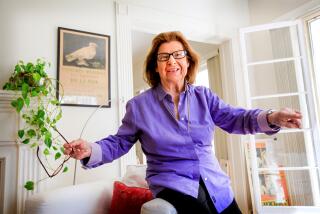MOVIE REVIEW : ‘50s Paranoia in ‘House on Carroll Street’
- Share via
There are problems in viewing the past through the prism of the present; our modern-day cliches may act as grit on the lens, clouding up otherwise clear pictures.
In “The House on Carroll Street” (selected theaters), director Peter Yates and writer Walter Bernstein want to convey the quiet paranoia of early ‘50s America in the first full bloom of the Red Scare.
This movie has a real ‘50s ambiance. The feel is there: in the quieter rhythms, the postwar-era shops and brownstones. And also in the mood--the smug complacency on top and, underneath, the dark, cynical Realpolitik games.
But . . . the film makers also try to shape their tale as a high-tension Hitchcockian romantic thriller, with hairbreadth escapes and racy set pieces. That dooms them.
“The House on Carroll Street” is a good little picture gone far too big: drowned in violent trimmings that diminish the strengths at its heart.
At that heart is a love story between blacklist victim Emily Crane (Kelly McGillis)--an ex-Life photo editor, hounded from her job by a Senate anti-subversives committee--and one of the FBI men tailing her, Cochran (Jeff Daniels). Two kinds of idealism mesh here: Emily’s sophisticated, urban radicalism and the sweeter, instinctive generosity of Cochran, the cornfed Midwestern good cop. Daniels’ square-jawed, ingenuous-looking grin and laconic comebacks are exactly right.
Against this simple drama, the formula machinations of the sub-Ludlum thriller plot become increasingly strained. Supposedly, Emily, in her exile, discovers Nazi war criminals being smuggled into America disguised as Jewish refugees, a conspiracy masterminded by the same smug, sneering Senate committee counsel, Ray Salwen (Mandy Patinkin), who got her blacklisted.
Patinkin seems to model this performance after the young Roy Cohn and Richard Nixon, and in the beginning he’s great. The opening sequence, with senators looking on silently as counsel Salwen smirks at Emily, ruthlessly overriding her speech--is in many ways the single most terrifying scene in “House on Carroll Street.” In purposely excessive comic thrillers like “The Manchurian Candidate,” the action sequences illuminate internal tensions. They don’t have to be plausible. But in “House on Carroll Street,” shaped in a more realistic framework, the action scenes seem intrusive. Though Yates executes them with panache, he can’t squeeze in any conviction.
The good things in “House on Carroll Street” (MPAA rated PG)--Daniels, Jessica Tandy as Emily’s tart benefactress, Christopher Rhode as a surly refugee, Patinkin’s first scene, Michael Ballhaus’ photography and Stuart Wurtzel’s production design--tend to survive the weak ones. But the producers--or Bernstein, a blacklist victim himself--may have indulged in too much wish-fulfillment and inflation.
The idea of a blacklist victim and an FBI man, in 1951, carrying out a love affair under the eyes of a vindictive Senate counsel is scary enough. They don’t really need this bizarre Nazi-smuggling caper. The elaborate thriller mechanisms--the murders, chases, fights, plunges through the Grand Central Station ceiling--just mess up the movie. And when Salwen pops up in Emily’s room and begins grilling her while she bathes, we’ve reached the ultimate Red Scare cliche in reverse. Is this guy hiding under every bed?
More to Read
Only good movies
Get the Indie Focus newsletter, Mark Olsen's weekly guide to the world of cinema.
You may occasionally receive promotional content from the Los Angeles Times.










